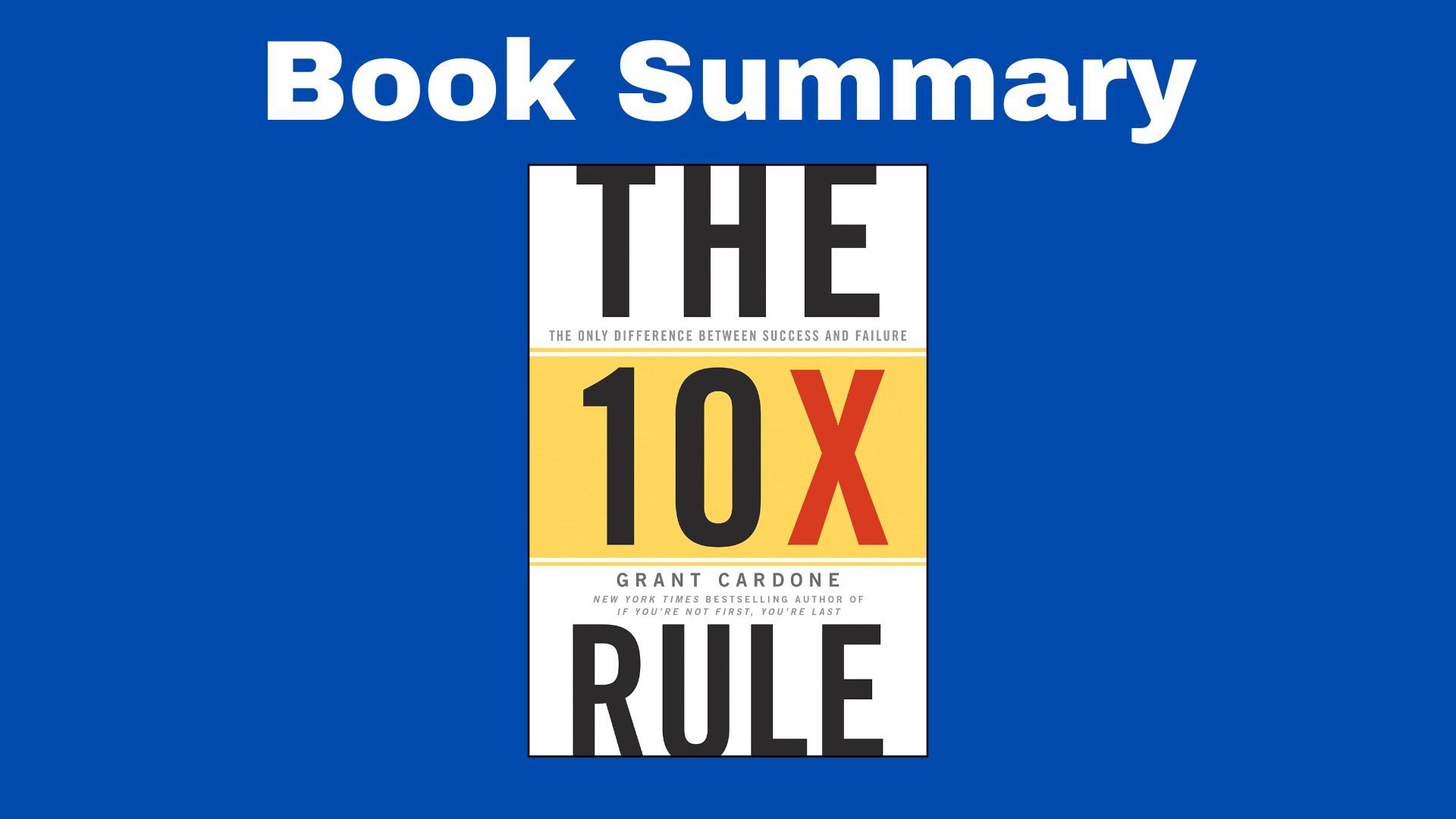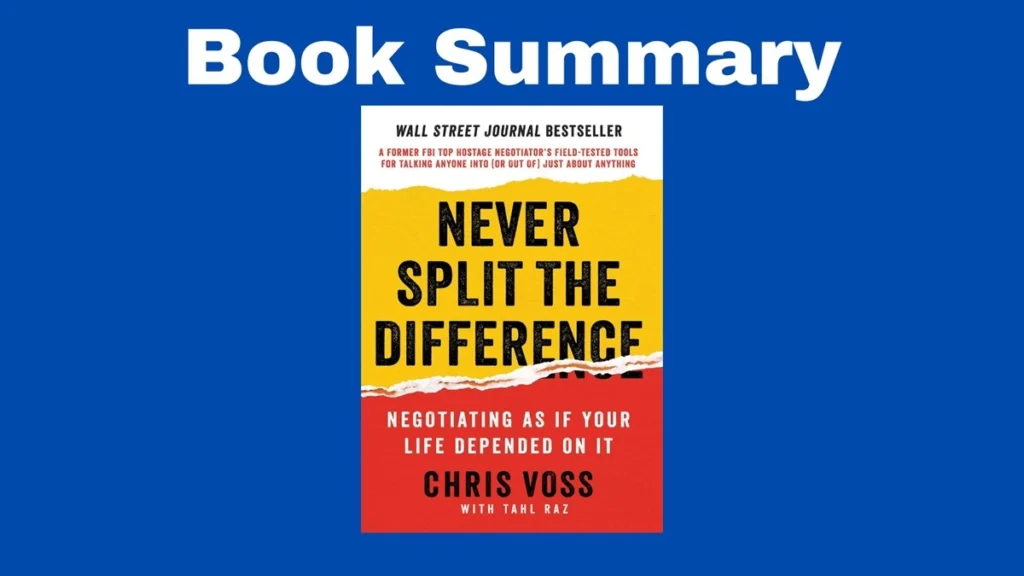The Book in Three Sentences
In this summary of The 10X Rule, you’ll learn to take massive actions to accomplish your business goals. The book assumes that most people operate with the three degrees of action (no action, retreat, or normal action), but Cardone suggests a fourth degree: the 10X Rule. In the book, you’ll learn a detailed plan to achieve massive success.
The 10X Rule Summary
Chapter 1: What Is the 10X Rule
The 10X rule guarantees that you can get anything you want in every area of your life. To apply the 10X rule, you first have to determine how much effort and thought you need to get something done. To a certain extent, failed endeavors of the past were unsuccessful because you underestimated the actions and reasoning necessary. So there are two parts to the 10X rule, assessing the level of effort needed to achieve a goal and adjusting your thinking. The author firmly believes that the one thing that makes a difference is the 10X rule.
It isn’t about luck, it isn’t about our genes, and isn’t about hanging out with the right people. The quality that makes a difference is putting in ten times as much work. Approach a business opportunity with massive action. In other words, operate at ten times the level that everyone else does. Once you achieve success, you’ll want to maintain that success and that requires attention and action. As part of the 10X rule, your targets should be ten times what you think you want and then do ten times what you think that will take.
These are the mistakes people make when they try to achieve goals:
- Mistargeting by having unmotivated objectives
- Underestimating the actions, resources, money, and energy you need to accomplish a target
- Competing in their sector instead of dominating
- Underestimating the problems you need to solve to achieve a goal. Avoid setting subpar targets because you won’t invest the required energy, effort, and resources.
The author defines success as the accumulation of events that let you achieve the desired outcome. Once you achieve success, you have to maintain it. This doesn’t mean that you have to work constantly because to have to follow perpetual success instead of “one-time” events.
Chapter 2: Why the 10X Rule Is Vital?
Regardless of which product, service, or proposition you have, there’s always something you don’t anticipate. Preparing for unexpected events is where the biggest opportunities lie, so commit from the beginning to increase your efforts ten times. By correctly estimating the effort necessary from the beginning, you develop persistence and you’re less likely to quit. On the other hand, miscalculating the effort you need to achieve something disappoints and discourages you because you’ll see the goal as unattainable and quit.
Furthermore, never reduce the target to make it seem more attainable. This sends the message that targets are unimportant and that you can change the rules however you please to win the game. Soon, you’ll find excuses for not reaching your goals.
In the 10X rule, the target isn’t the problem. Any target approached with the correct actions and level of persistence is achievable. Right from the get-go, assume that every project will take more time, money, energy, effort, and people. Multiply your expectations by ten and adopt an aggressive mindset. In other words, success doesn’t just happen, it’s the result of taking the correct actions over time.
Chapter 3: What Is Success?
Success means something different to everyone. That said, there are some crucial parts to success.
- Success is important
- Success is your duty
- There’s no shortage of success
Success is important: success is vital to the well-being of a person, small community, or society. It gives you confidence, security, comfort, and hope. Without growth, a person, corporation, dream, or race would die. When expansion stops, disaster ensues. Never minimize the importance of success.
Chapter 4: Success Is Your Duty
By approaching success with duty, obligation, and responsibility, you’re more likely to get it. Don’t see success as something that may or may not happen and don’t treat it like an option. You need an aim, a purpose, or focus, and a sense of direction, but to get it, you need to commit to seeing success as an obligation.
Whatever you do, don’t minimize how valuable success is to you. Admit that you want something even if you can’t get it. Admitting you want something might be the first step towards getting it even if there are obstacles along the way. Success is all about momentum. Once you achieve a goal, you’ll set and get bigger goals. Finally, success is often the result of countless steps in the right direction.
Chapter 5: There Is No Shortage of Success
Success has no limit and despite what people believe, it isn’t scarce. The fact that someone else is successful doesn’t prevent you from being successful too. In fact, success is created, not acquired. Seeing other people’s success is invigorating.
Chapter 6: Assume Control of Everything
People who complain and victimize themselves repel success. To succeed, you have to take big actions, but you can’t do that if you’re busy coming up with excuses. Success doesn’t happen to you, but because of you. Take responsibility for your actions. By doing this, you can change something to improve your future situation.
There are four consistent factors of victims:
- Something bad always happens to them
- Something bad happens to them often
- They are involved
- Someone or something else is at fault
Successful people take responsibility for what happened and they are constantly looking for solutions to possible problems they might encounter.
Chapter 7: Four Degrees of Action
A lot of people are interested in knowing how much action is needed to succeed, but there’s no secret shortcut. The only thing you need to know is that more action means more chances to succeed. Actions have to be disciplined, consistent, and persistent.
There are four choices of action:
- Do nothing
- Retreat
- Take normal levels of action
- Take massive action
The First Degree of Action: Doing Nothing
Doing nothing means not taking action. This means the person in question gave up and is ready to accept the consequences. All degrees of action require a certain amount of effort, work, and energy, including doing nothing. Doing nothing comes in the form of boredom, lethargy, complacency, and lack of purpose.
The Second Degree of Action: Retreating
This is taking action in reverse to avoid negative experiences that happen as a result of doing something. This person has probably failed at something and then decides to avoid taking action in order to avoid failure. This also requires effort and work. Retreating requires some kind of action and the people who engage in it justify why they’re retreating.
The Third Degree of Action: Taking Normal Levels of Action
This is doing what’s necessary and nothing else. This is being normal, comfortable, middle class, acceptable, average, and never going the extra mile to actually succeed. Only when problems come up, do they realize that they’re at risk. Average delivers mediocre results.
The Fourth Degree of Action: Mass Action
If you’re focused and have the proper direction, taking massive action can be transformative. Taking massive action can lead to problems and you should welcome these problems with open arms because they’re part of the process. If people admire your level of activity and commitment, that means you’re on the right track. You’ll be ridiculed, criticized, and judged as well. You’re in massive action if 1) you create problems for yourself and 2) you receive criticism from others. Massive action never hurts.
Chapter 8: Average is a Failing Formula
Most things in life are average. Accepting what’s average kills your dreams and it doesn’t work in any area of your life. All projects that embrace average end up in failure. Plant to succeed so big that nothing can bring you down. Sometimes it pays not to be conservative and safe.
Chapter 9: 10X Goals
Most people don’t stick to their goals because they don’t set them high enough. Realistic goals are a letdown. Important things in life depend on writing goals down on a daily basis and choosing objectives that are slightly out of reach.
Your goals have to be big and aligned with your purpose. Refuse to set small, attainable, and realistic goals. When it comes to goals, remember you’re setting them for yourself, so anything goes. You have more potential than you think, success is your possibility, there’s no shortage of success, and all goals, both big and small, require work.
You should:
- Set 10X targets
- Align those targets with your purposes
- Write them down daily both when you wake up and when you go to bed
Chapter 10: Competition Is for Sissies
In the business world, you should dominate, not compete. Competing limits your ability to be creative because you’re focusing on what someone else is doing. Your goal should bever be to compete. Try to make it your mission to dominate your sector, set the pace, and make it so that others chase you. To dominate, do what others refuse to do. This creates an unfair advantage. Dominating is when your brand or name becomes synonymous with the thing you do. There’s a lot of noise in the marketplace, so you have to get noticed and get through the noise. By taking the right amount of action, you’ll get new problems and your competition will promote you. Determine the capability, actions, and mindset of your competition and exploit it. Be willing to do what others won’t.
Chapter 11: Breaking Out of the Middle Class
Being part of the middle class is the wrong goal to have. Break out of the “middle-class mentality” instead. The middle class suffers pain and insecurity, they are trapped, manipulated, and at constant risk. Members of the middle class go after what’s necessary rather than going big.
Chapter 12: Obsession Isn’t a Disease; It’s a Gift
Being obsessed is treated like a disease, but this is how you should approach success. Obsession has a negative connotation, but it’s a requirement to achieve your goals. Most people lack this obsession which is why they’re never rewarded with success. You can’t achieve greatness without obsession. Be passionate, persistent, and obsessed.
Chapter 13: Go “All In” and Overcommit
Go “all in” and commit to every opportunity. This involves betting your efforts, creativity, energy, ideas, and persistence. Despite what you might think, you never run out of chips and you can go “all in” as many times as you want. You have everything to win and nothing to lose. Overcommit, but also overdeliver. Create new problems for yourself, which means you’re taking action.
Chapter 14: Expand – Never Contract
The world is contracting: everyone is reducing, saving, and being careful. But few people and companies are expanding. Contracting is a way of retreating and when you retreat, you continue to act, produce, and create. As long as you stick with it, expanding will work.
Chapter 15: Burn the Place Down
When you take 10X action, you gain traction. Continue building the fire until you burn everything down. Under no circumstance should you stop. Keep taking action until you gain momentum. Overexposure is never the problem, obscurity is, so don’t hide.
Chapter 16: Fear Is the Great Indicator
Taking new actions is scary. You shouldn’t avoid fear though, look for it and embrace it. Fear is a sign that you’re going in the right direction. Furthermore, fear is caused by emotions and not rational thinking, so don’t let your fear grow because otherwise, it’ll take over. When you’re scared of something, do it. Fear tells you what to do and when. Take action now. Fear paralyzes people, and drains their energy, momentum, and confidence. Fear indicates the actions that will give you the greatest return.
Chapter 17: The Myth of Time Management
To make success your duty, you have to set your priorities. Don’t think in terms of balance, this limits what you can or can’t have. You can have abundance in all areas of your life. Take control of your own time and don’t let others do it for you.
Additionally, track how you spend your time and try to find all the habits and activities that don’t contribute to your success. As you grow older, your priorities will change and you’ll have to modify them. After all, you’re the only one who can decide how you’re going to use your time.
Chapter 18: Criticism Is a Sign of Success
Getting criticism means you’re doing something right and it’s something you should expect on your way to success. Criticism means you’re visible and getting attention and it comes in many forms, such as advice. Criticism precedes admiration and is part of success.
Chapter 19: Customer Satisfaction Is the Wrong Target
Don’t pursue customer service, increasing customers should be your primary target. Satisfy customers and give them what they want, but prioritize generating customers above everything else. Once you have customers, you can worry about making them happy. Focus on customer acquisition first and then move on to customer service. Remember that there’s no customer service without customers first. To get quality, you first have to focus on quantity.
- Customer acquisition
- Customer loyalty
- Word of mouth
Chapter 20: Omnipresence
Being omnipresent is being everywhere all the time. If what you sell (a product, service, idea, or brand) is universal, then it can amass success. So make yourself available and get people’s attention. When your actions are too small, it’s a grind. When your actions are too big, it’s passion.
Chapter 21: Excuses
Confront your own excuses. Excuses are justifications for doing or not doing something. The problem with excuses is that people who use them don’t take responsibility for their own life. Successful people, on the other hand, don’t make excuses.
Chapter 22: Successful or Unsuccessful
Successful people have the following traits:
- Have a “can do” attitude. This is the attitude that anything is possible.
- They believe they’ll figure it out.
- They focus on opportunity. Successful people see situations as possibilities. Difficulties are part of the journey to success. Success is overcoming those challenges. The bigger the problems, the bigger the opportunities they’ll have.
- Love challenges. Highly successful people value challenges.
- Seek to solve problems. Every problem is universal.
- Persist until successful. Be more persistent than talented.
- Take risks.
- Be unreasonable. Act unreasonably, do the impossible, and don’t play by the rules.
- Be dangerous. Being careful all the time does more harm than good.
- Create wealth. Make money by providing new ideas, products, services, and solutions.
- Readily take action.
- Always say “yes”.
- Habitually commit.
- Go all the way.
- Focus on “now”. The successful spend time in the now or the future. The unsuccessful spend time in the past.
- Demonstrate courage.
- Embrace change. Don’t alter what works, but improve what you’re doing.
- Determine and take the right approach. Determine what works and what doesn’t work.
- Break traditional ideas: challenge traditions and come up with new ways to do things.
- Be goal-oriented. The target is more important than the problem.
- Be on a mission. What you do isn’t a job, but a religious mission.
- Have a high level of motivation. Never feel satisfied.
- Be interested in the results.
- Have big goals and dreams. Have big, unrealistic goals.
- Create your own reality. Create the reality you want to make.
- Commit first and figure it out later.
- Be highly ethical. Pay by society’s rules and do what you instruct others to do. Do that until you get the results you want.
- Be interested in the group. You’re only as good as the kind of people you surround yourself with.
- Be dedicated to continuous learning.
- Be uncomfortable. Successful people are willing to put themselves in uncomfortable situations. Unsuccessful people look for comfort.
- “Reach up” in relationships. Surround yourself with people who are smarter, brighter, and more creative than you.
- Be disciplined. This is what you need to do activities until they become normal.
Chapter 23: Getting Started with 10X
Use as many of the techniques highly successful people use and do it now. Commit to whatever it is that you do and commit to it fully. Here are some things to bear in mind:
- Do not reduce your goals
- Don’t focus on the small details
- Figure out what you can do to get closer to your goals
- Take the actions you come up with
- Don’t evaluate the outcome of your actions too soon
- Review the list often
Further Reading
If you liked this summary of The 10X Rule, you might also like:




